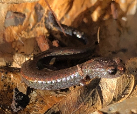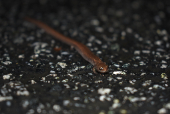Gabilan Mountains Slender Salamander (B. gavilanensis)
Description: Adults are 1 1/2 to 2 3/5 inches long from snout to vent, or 3 3/4 to 6 1/2 inches in total length. A small thin salamander with 19-22 costal grooves.Short limbs, a narrow head, long slender body, very long tail, and conspicuous costal and caudal grooves give this species the worm-like appearance typical of most Slender Salamanders. There are four toes on the front and hind feet, which is typical of all Slender Salamanders. (Other California salamanders have five toes on the hind feet.) Gray with brownish black ground color and there may be a distinct brownish gray to coppery tan dorsal stripe extending onto the tail and bordered by blackish dots. Small whitish speckling mark the sides.
Habitat: Habitats include moist redwood forests, gray pine and mixed evergreen forests, oak woodlands, chaparral, and open grasslands with scattered oaks. Habitat at the southern end of the range tends to be hot and semi-arid, and populations are localized in moist areas on north-facing slopes. Typically found under rocks, logs, bark, driftwood, and other surface debris.
Range: Endemic to California. Occurs along the central coast of California from the base of the Santa Cruz mountains at Rodeo Gulch, Santa Cruz County, southward to the eastern margin of the city of Monterey, at Jack's Peak. Occurs inland into the Gabilan and Diablo mountains and the east slope of the Santa Lucia mountains south into northern San Luis Obispo county, and the Temblor Range in Kern County (where salamanders are tentatively assigned to this species.)
Found in these States:
CA
Diet: Eats a variety of small invertebrates. A sit-and-wait predator, using a projectile tongue to catch prey.
Reproduction: Reproduction is terrestrial. Egg deposition sites are unknown. It is assumed that females lay eggs in moist places underground as with other species of Batrachoseps. Young develop completely in the egg and hatch fully formed.
Status: Listed as Least Concern since, although its extent of occurrence (EOO) is less than 20,000 km2, it is common and occurs in an area of extensive and suitable habitat in which threats are very localized.
»» Kingdom: Animalia - Animals
»» Phylum: Chordata - Chordates
»» Subphylum: Vertebrata - Vertebrates
»» Class: Amphibia - (Amphibians)
»» Order: Caudata - Salamanders
»» Family: Plethodontidae - Lungless Salamanders
»» Genus: Batrachoseps
»» Species: B. gavilanensis - Gabilan Mountains Slender Salamander
This article uses material from the Wikipedia article "Gabilan Mountains Slender Salamander", which is released under the Creative Commons Attribution-Share-Alike License 3.0. Content may have been omitted from the original, but no content has been changed or extended.
|







